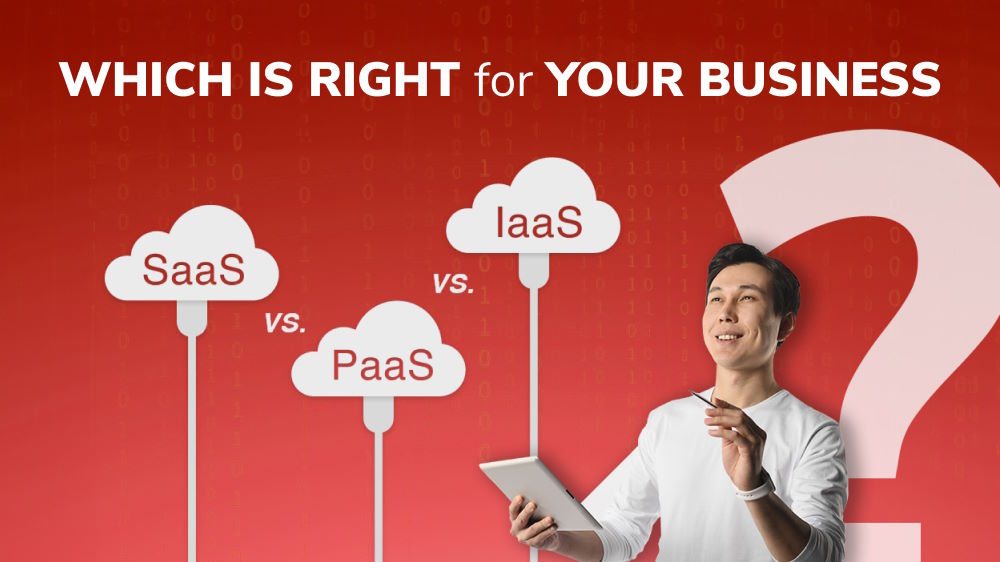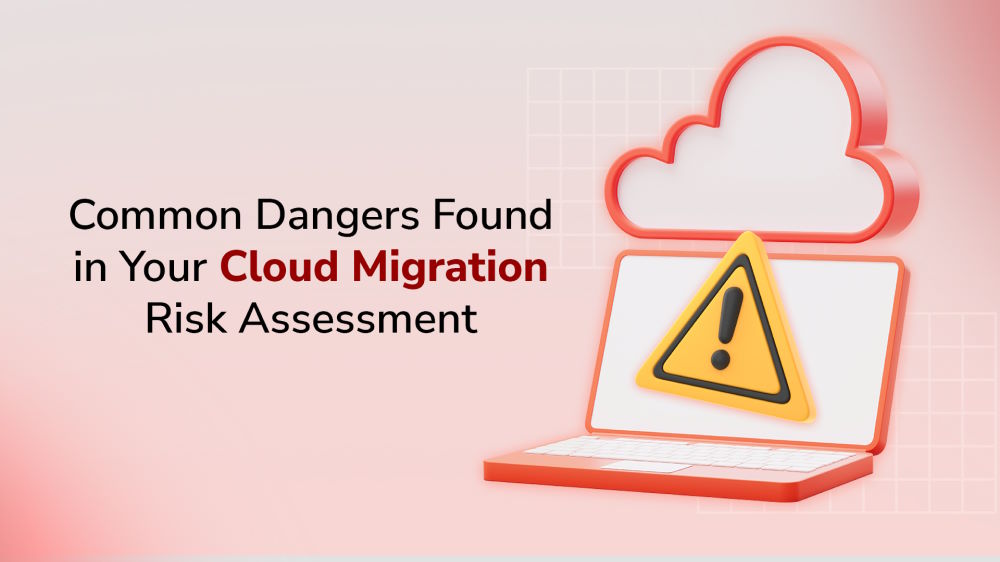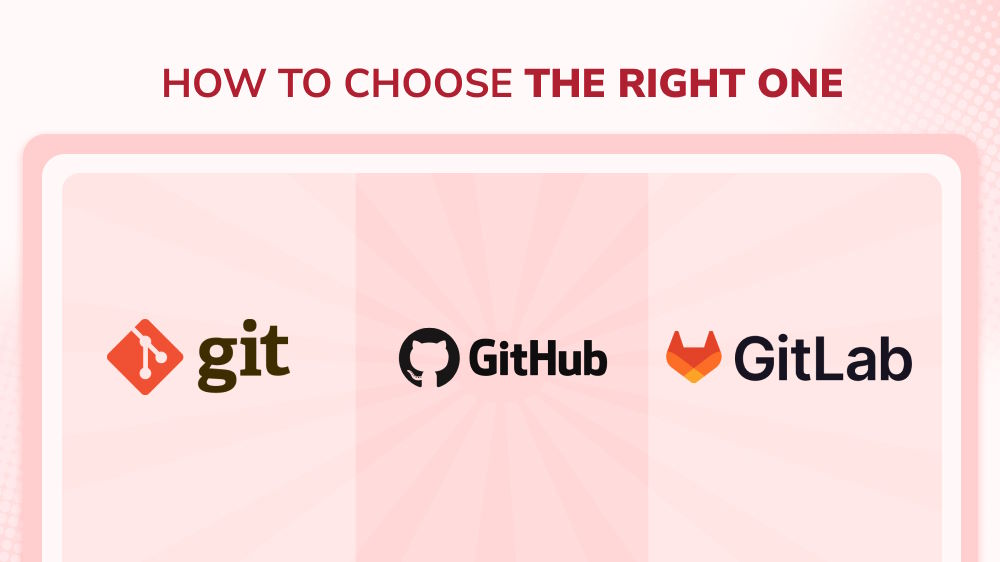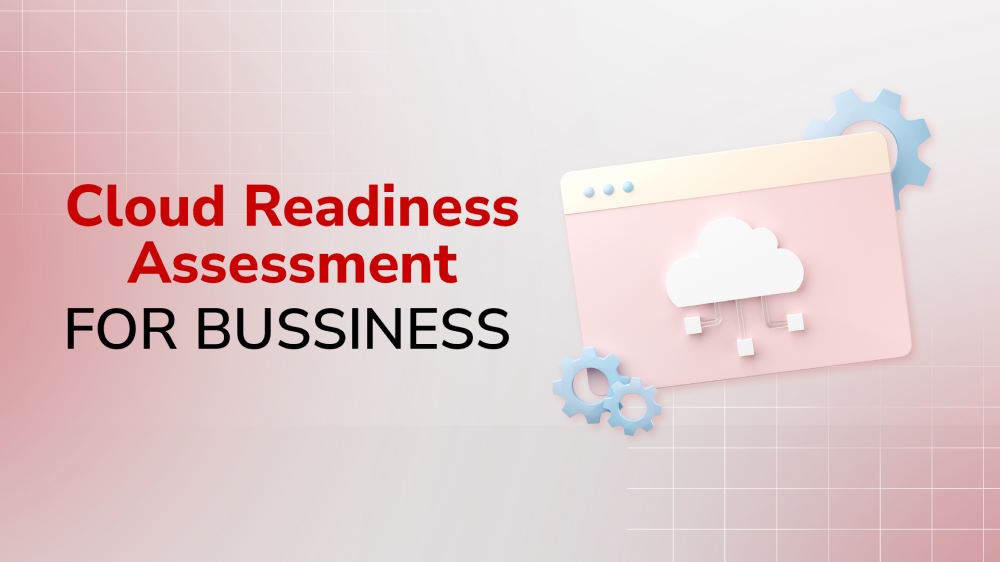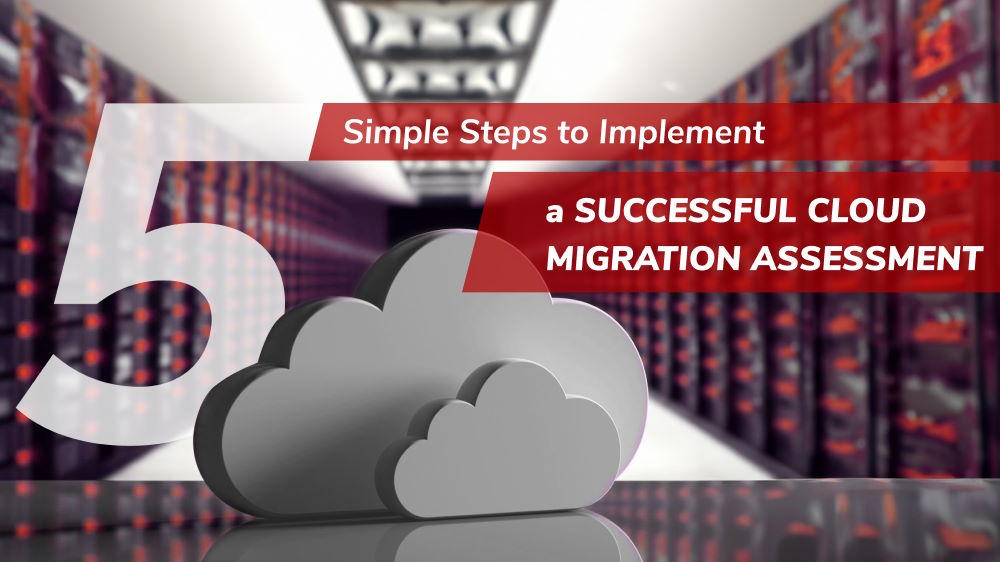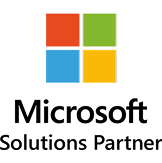
Demystifying Enterprise Cloud Computing
This guide will provide you with a holistic view of enterprise cloud computing and essential insights needed for a successful adoption.

Content Map
More chaptersCloud computing used to be seen as a fad back in the early 1960s when John McCarthy proposed that computing resources could be delivered on demand as services. The term “cloud computing” was brought to the mainstream by Amazon Web Service in 2006 –2007 as a way of renting virtualized computing resources in an infinitely scalable environment. And look at where we are standing now - a digital world where cloud computing services have become a norm.

The transition from traditional IT infrastructure to cloud technology has become the backbone of digital transformation. A major portion of modern businesses have shifted from relying on on-premise infrastructure to embracing cloud resources. Statistics indicate that 72% of companies invest over $1.2 million in the cloud per year, and 37% of large corporations exceed the annual expenses of $12 million on cloud technology.
Key Takeaways:
- Enterprise cloud computing refers to the application of cloud infrastructure in a business setting.
- Enterprise cloud architecture is structured through deployment models like public, private, hybrid, multi-cloud, and distributed cloud. Each offers varying levels of control, scalability, and flexibility depending on business needs.
- Cloud services fall into IaaS, PaaS, SaaS, and FaaS, allowing businesses to offload infrastructure, streamline development, access ready-to-use apps, and run event-driven functions - all with improved efficiency and cost control. Solutions like Hyper-Converged Infrastructure (HCI) and Disaster Recovery Management (DRM) enhance agility, simplify infrastructure, and ensure business continuity in today’s fast-evolving digital environments.
- Enterprise cloud adoption offers key benefits such as reduced IT costs, enhanced business continuity, strengthened data security, and improved collaboration.
- While enterprise cloud computing offers significant advantages, organizations must overcome key challenges, including data security risks, vendor lock-in, regulatory complexity, and internal skill gaps, to unlock its full potential.
What Is Enterprise Cloud Computing?
The term “enterprise cloud computing” represents a convergence of business strategy and technological innovation. But it is not as complex as it sounds. At its core, it simply refers to the application of cloud technologies in a business setting.
Organizations are enabled to access and utilize scalable, on-demand IT resources without investing in expensive physical infrastructure. The enterprise cloud model involves adopting cloud infrastructure and services to achieve strategic business goals, whether that means modernizing legacy systems, streamlining business operations, or driving digital transformation.
Unlike on-premises infrastructure, enterprise clouds center around operational consistency and automated governance, which allows IT teams to manage complex, multi-platform environments (such as hybrid or multi-cloud) without losing visibility or control.
Types of Enterprise Cloud Architecture
Cloud architecture refers to the design and structure of computing components within a cloud environment and how they are delivered to users via the internet. Typically, cloud architectures are categorized by two primary frameworks: Deployment models and service models.
Cloud Deployment Models
Public Cloud
The public cloud is a shared environment that allows multiple users to access virtualized data centers simultaneously. These data centers, along with the underlying infrastructure and services, are monitored and maintained by third-party cloud providers like Amazon Web Services (AWS), Microsoft Azure, and Google Cloud Platform (GCP). Public cloud resources are delivered and shared across organizations over the internet in a multi-tenant model.

Public cloud platforms operate on a pay-as-you-go pricing model, enabling enterprises to scale resources up or down dynamically based on evolving business needs. This approach helps organizations manage costs more efficiently by paying only for the resources they use. Public cloud services are especially well-suited for variable workloads and diverse use cases, including data storage, networking, analytics, machine learning, containerization, and application development.
Although the public cloud model offers a cost-effective and scalable solution, it comes with certain trade-offs. Compared to private or hybrid cloud architectures, it provides less customization and control over infrastructure. Additionally, while public clouds incorporate robust security measures and adhere to strict compliance standards, they remain shared environments. This means security and governance become a shared responsibility between the provider and the users.
Private Cloud
A private cloud refers to a single-tenant environment in which computing resources (including hardware infrastructure and software components) are dedicated to an organization. Unlike public cloud architectures, where resources are shared among multiple tenants, private clouds ensure that only authorized users in the organization have access to their infrastructure and data.

Organizations can deploy private cloud infrastructure either on-premises (within their own data centers) or through a hosted model managed by a third-party provider. In both cases, the environment is isolated, offering tailored configurations and stronger access control mechanisms.
Private cloud solutions provide greater customization, governance, and control over the organization’s IT infrastructure, making it ideal for enterprise businesses with strict regulatory requirements, sensitive data, or legacy system dependencies. Also, private clouds are more secure than public environments due to network isolation and dedicated resources.
However, the private cloud model can be more expensive compared to public cloud solutions. Organizations have to bear the expenditures in hardware procurement, infrastructure setup, and ongoing maintenance and expansion. As workloads grow, the need for scalable storage and computing capacity can significantly increase capital and operational expenses. That’s why many enterprises choose to partner with managed service providers (MSPs) who specialize in private cloud deployment and operations. These vendors handle the underlying complexities and help businesses reduce the burden of their internal IT teams.
Hybrid Cloud
This cloud computing model integrates public and private cloud environments to enable the sharing of data and applications between them. Hybrid cloud environments provide organizations with the flexibility to place workloads in the most appropriate environment based on performance, cost, security, and compliance needs.

By combining the security and control of private cloud platforms with the scalability and cost-efficiency of public clouds, hybrid architectures empower enterprises to optimize their IT operations. For instance, businesses can retain sensitive data or mission-critical applications in a private cloud while leveraging public cloud platforms for less-sensitive, high-volume, or burst workloads.
A key advantage is that the hybrid model supports gradual cloud adoption. Organizations can leverage cloud computing and modernize legacy systems without disrupting existing operations. This makes it particularly appealing for industries that face stringent regulatory requirements or operate on legacy infrastructure.
However, hybrid cloud infrastructure requires more advanced technical expertise for maintenance, integration, and monitoring. This added complexity can increase operational costs compared to managing a single cloud environment. Additionally, the security of hybrid clouds may be compromised if not properly configured and governed, as maintaining consistent policies across both public and private environments can be challenging.
Multi-Cloud
In this model, organizations can use two or more cloud platforms from different providers to run applications, manage data, and deliver services. The multi-cloud strategy allows businesses to distribute workloads across multiple environments while taking advantage of the unique capabilities and pricing structures offered by different cloud service providers.

The downside of a multi-cloud architecture is that it demands meticulous management and coordination across cloud providers, which can often be complex and resource-intensive. Business owners may face challenges in interoperability, consistent security policies, and unified monitoring across disparate platforms. Moreover, while multi-cloud strategies help mitigate traditional vendor lock-in, they can introduce a form of operational lock-in - where deeply integrated, provider-specific services make it costly or technically difficult to migrate workloads between platforms.
Distributed Cloud
In this cloud computing model, cloud resources and services are deployed across multiple physical locations closer to end users. Unlike hybrid or multi-cloud architectures, where organizations manage disparate environments or providers, the operation, governance, and updates in a distributed cloud remain centrally managed by the originating cloud provider.
Common Cloud Computing Services
Infrastructure as a Service (IaaS)
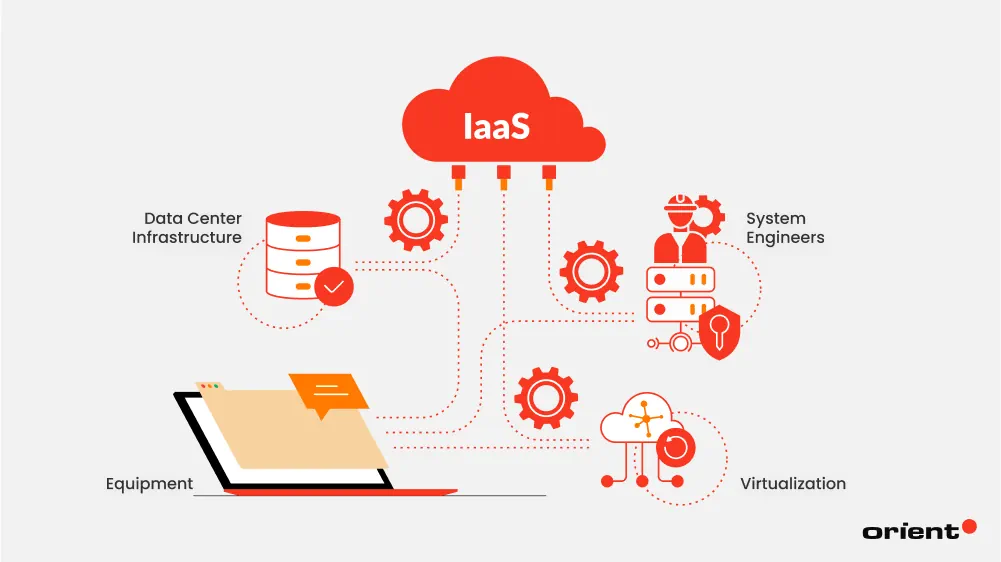
IaaS is a service model that delivers virtualized computing resources (such as servers, storage, and networking) with internet access. Infrastructure as a Service replaces the need for organizations to purchase, house, and maintain physical hardware by offering scalable infrastructure on demand. This model aims to reduce capital expenditures and operational complexity while scaling resources dynamically based on workload requirements.
Examples: Amazon EC2, Microsoft Azure Virtual Machines, Google Compute Engine.
Platform-as-a-Service (PaaS)

PaaS delivers a fully managed environment for application development and deployment. Ready-to-use cloud platforms address infrastructure concerns and enable developers to focus solely on coding and building features. PaaS includes tools for version control, continuous integration/continuous deployment (CI/CD), and application monitoring. It enables accelerating time to market and lowering development costs.
Examples: Google App Engine, Heroku, and Microsoft Azure App Service.
Software-as-a-Service (SaaS)
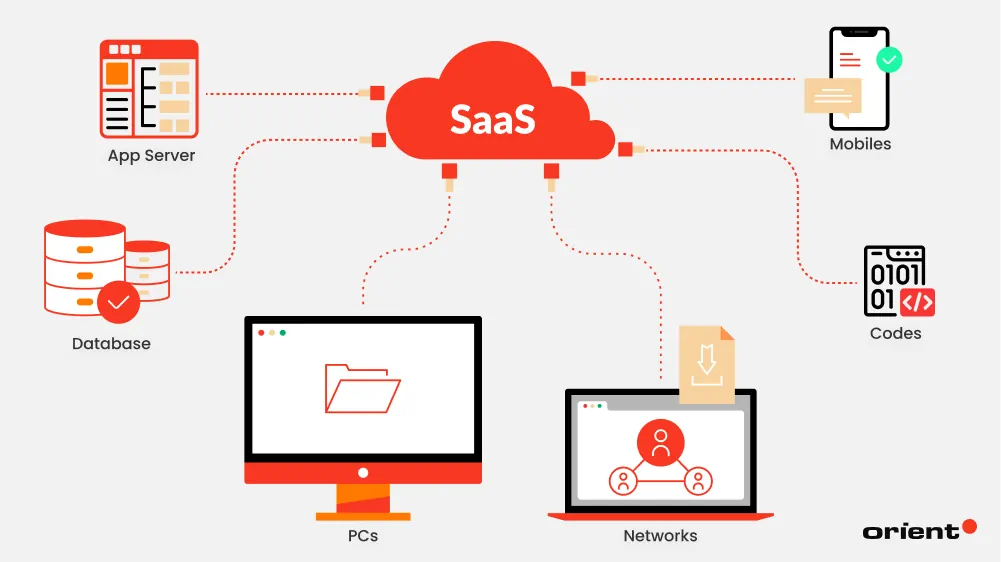
This type of enterprise cloud solution allows organizations to access, use, and manage applications through the network without having to install or maintain any hardware components. This model eliminates the need for upfront software license purchases and is typically offered on a subscription or pay-as-you-go basis.
Examples: Salesforce, Microsoft 365, Google Workspace, Dropbox.
Function-as-a-Service (FaaS)
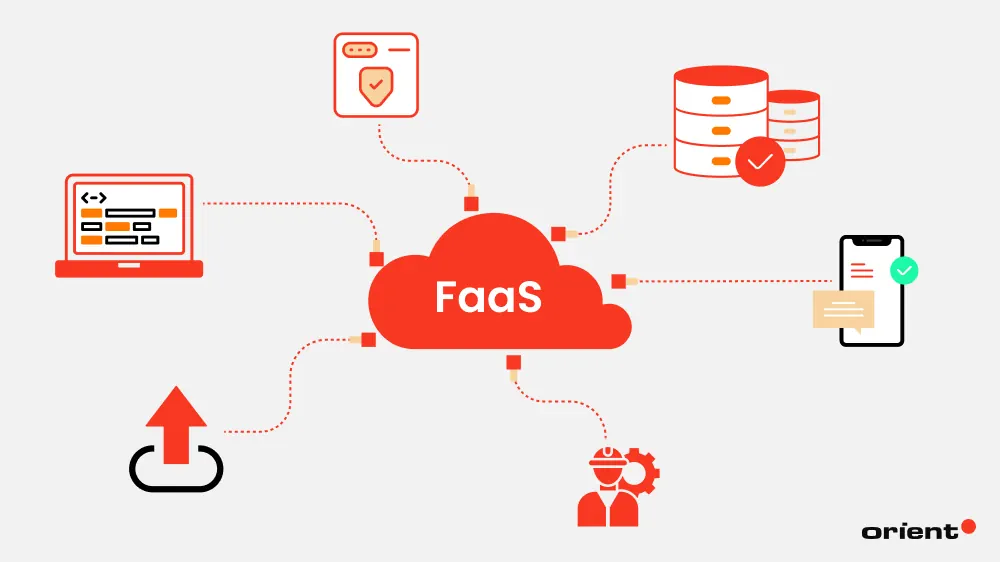
Faas is a serverless cloud computing service model in which developers can deploy individual functions or blocks of code in response to events without provisioning or managing servers. The cloud provider handles the infrastructure, scaling, and runtime management. FaaS is ideal for event-driven architecture. It offers excellent scalability, cost-efficiency, and agility, as users are charged only for the actual execution time of their functions.
Examples: AWS Lambda, Azure Functions, and Google Cloud Functions.
Advanced Enterprise Cloud Solutions
As cloud technology matures, enterprises can consider adopting advanced infrastructure solutions to enhance operational agility, resilience, and cost-effectiveness.
Hyper-Converged Infrastructure (HCI)
HCI is a modern approach to data center architecture that combines computing, storage, and networking components into a single, software-defined system. Unlike traditional infrastructure, where components are siloed, HCI leverages virtualization and intelligent software to integrate them into a single, scalable platform.
Disaster Recovery Management (DRM)
It refers to the strategic planning and use of cloud-based tools to quickly restore IT systems, data, and services in response to system failures, natural disasters, cyberattacks, or other disruptive events. DRM solutions help organizations ensure business continuity.
The Key Drivers of Enterprise Cloud Adoption
Enterprise cloud computing has fundamentally transformed the way organizations operate and manage their IT infrastructure.
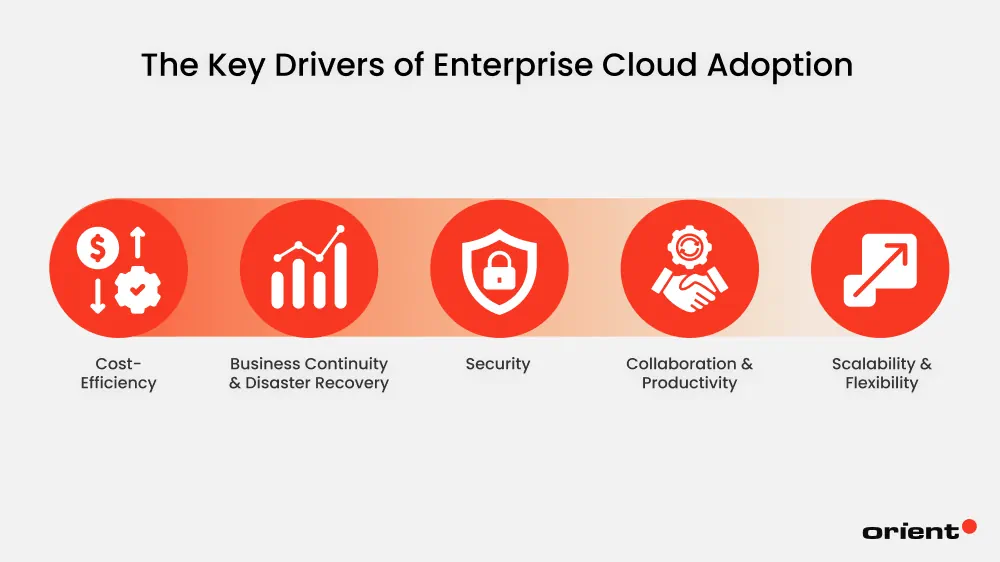
Cost-Efficiency
One of the most compelling advantages of enterprise cloud computing is cost savings. Organizations do not need to invest in costly hardware and infrastructure. Instead, they can opt for pay-as-you-go or subscription-based cloud services.
The consumption-based model ensures that businesses only pay for the resources they use, reducing waste. Additionally, cloud providers handle maintenance and upgrades so businesses can avoid ongoing operational costs tied to traditional IT environments.
Business Continuity & Disaster Recovery
The enterprise cloud strategy, if implemented logically, can streamline business operations and enhance business continuity by replicating data across geographically dispersed data centers. In the event of a unforeseen disaster or system failure, cloud-based backup and recovery solutions allow organizations to quickly restore operations with minimal disruption. These capabilities significantly reduce downtime and ensure critical services remain available during unforeseen events.
Security
Leading cloud providers implement robust, enterprise-grade security frameworks, including firewalls, encryption, identity and access management (IAM), and multi-factor authentication. They also provide continuous monitoring, patch management, and compliance support for regulations such as GDPR, HIPAA, and ISO standards. This enables organizations to safeguard sensitive data and maintain a strong cloud security monitoring posture, even in highly regulated industries.
Collaboration & Productivity
Cloud computing facilitates real-time collaboration by allowing teams, partners, and customers to access shared resources and workspaces from any location they find convenient. Integrated tools, such as document sharing, project management, and communication platforms, streamline workflows and reduce manual data transfers. This leads to faster decision-making, improved team coordination, and greater overall productivity.
Scalability & Flexibility
Enterprise cloud solutions are inherently scalable. Businesses, especially large ones, can quickly adjust resources to meet fluctuating demand. Whether scaling up during peak periods or scaling down to optimize costs, cloud platforms offer unmatched agility. Additionally, businesses can easily switch services, integrate third-party tools, or move workloads between cloud environments. It enables rapid adaptation in dynamic market conditions.
Challenges of Cloud Computing in Enterprises
The transformative benefits are real. Still, enterprise cloud computing presents several critical challenges that organizations must navigate to fully realize their potential.

Data Security
Cloud providers offer robust security frameworks, but enterprises may still face difficulties in data protection across distributed environments. Misconfigurations, weak identity controls, and shared responsibility models can expose sensitive assets. The rise of sophisticated cyber threats and the complexity of multi-cloud architectures further emphasize the need for cloud-native security strategies and zero-trust frameworks.
Vendor Lock-In
Adopting cloud services leads to tight coupling with proprietary APIs, tools, or platforms, so it may be difficult to migrate workloads or switch providers. This lack of portability limits flexibility and can drive up long-term costs. As a result, enterprises are increasingly adopting open-source orchestration tools like Kubernetes to abstract infrastructure and improve interoperability across cloud environments.
Regulatory Compliance
Global enterprises must navigate a complex web of data privacy and residency laws, such as the EU’s GDPR and the U.S. CLOUD Act, which often conflict. Ensuring compliance while operating across jurisdictions requires careful architectural planning, data localization, and regular audits. Failing to comply can result in substantial fines and reputational damage.
Internal Skill Gaps
A major barrier to effective cloud adoption is the shortage of skilled cloud professionals, particularly in areas like cloud management, security, governance, and DevOps. According to industry data, 68% of enterprises report insufficient cloud security expertise. This percentage highlights the urgent need for ongoing training, certification programs, and cross-functional upskilling to support cloud operations.
Conclusion
Enterprise cloud computing is no longer a vision for the future. It is now a present-day necessity for organizations aiming to stay competitive, scalable, and resilient in a digital-first world. By understanding the various cloud architectures, service models, strategic benefits, and obstacles in enterprise cloud adoption, business owners can make informed decisions that align with their goals, regulatory requirements, and technical capabilities. However, successful cloud adoption isn’t just about choosing the right platform. It’s about building the right solution. So, let Orient Software help you shape your cloud success.

At Orient Software, we specialize in guiding businesses through every stage of their cloud journey. From IT consulting and cloud strategy planning to custom software development and system integration, our experts help you harness the full potential of cloud technologies. Whether you’re modernizing legacy systems, developing cloud-native applications, or seeking end-to-end digital transformation, Orient Software is your trusted partner in building tailored, future-ready enterprise solutions. Contact us today.

